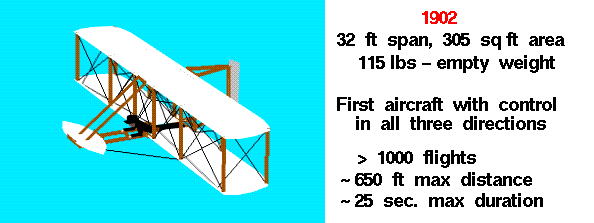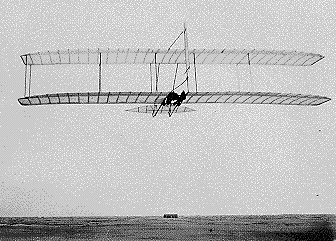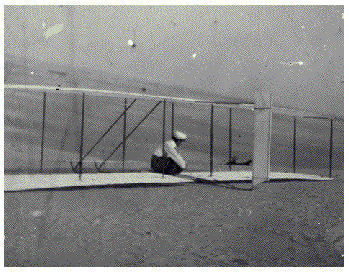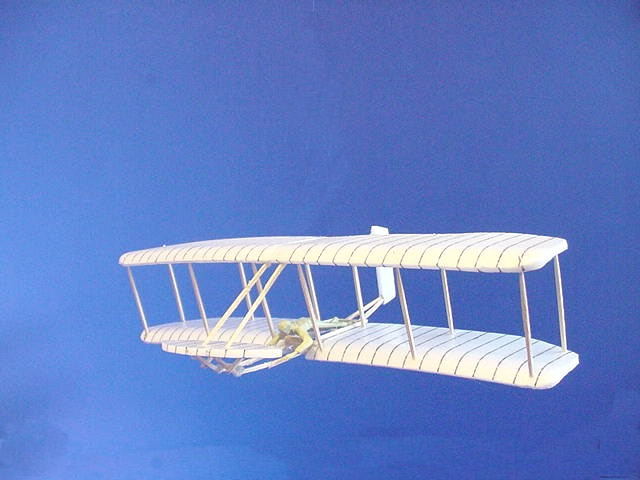
 |
|
Glenn
|

This page shows a computer drawing of the Wright brothers' 1902 aircraft. This was the third unpowered aircraft built by the brothers. The aircraft was flown repeatedly at Kitty Hawk, North Carolina, during 1902 as a piloted glider and as a kite. The Wright brothers used this aircraft to answer some of the problems encountered with the 1901 aircraft. They also used this aircraft to develop their piloting skills because this was the first aircraft in the world that had active controls for all three axis; roll, pitch, and yaw.
The 1902 aircraft has two wings and an elevator/stabilizer mounted in the front like the 1901 aircraft. As with previous aircraft, the pilot lies on the bottom wing and controls the roll of the aircraft by warping the wing shape. On the 1902 aircraft, and on all later flyers, the warping was controlled by a hip cradle instead of the pedals on the 1900 and 1901 aircraft.
You can study the design of the 1902 aircraft by changing the view using the buttons at the bottom of this Java program.
You can download your own copy of this applet by pushing the following button:
The program is downloaded in .zip format. You must save the file to disk and then "Extract" the files. Click on "1902.html" to run the program off-line.
There are some major differences between this aircraft and its predecessors. Data from the 1901 wind tunnel experiments showed that a longer, thinner wing gave less drag and a better L/D ratio than a short thick wing. So the aspect ratio (ratio of wing span to wing chord or width) was changed from 3:1 on the 1901 aircraft to 6:1 on the 1902 aircraft. In an attempt to solve the problem of adverse yaw from the 1901 glider, two 6-foot rudders were added to the rear of the craft. Initially, these rudders were fixed to their struts to keep the nose pointed straight ahead.
Test flight went better than in 1901, but in about one glide in 50 the glider would spin out of control on recovering from a turn at low speed. Lying awake one night, Orville concluded that the rudders were acting as vertical wings in which turning generated an angle of attack and thus an unwanted force in the wrong direction. His solution was to replace the twin fixed rudders with a single moveable rudder. The next morning Wilbur agreed and offered the idea to tie the rudder turning into the wing warping system. Once done, the glider worked beautifully, keeping the nose of the aircraft pointed into the curved flight path. On the 1902 aircraft, the pilot could also change the angle of the elevator to control the up/down position or pitch of the nose of the aircraft. For the first time in history a craft could be controlled in three dimensions. With this new aircraft, the brothers completed over a thousand gliding flights; flying over 650 feet in length, staying aloft for nearly 30 seconds a flight, and flying in high winds. By the end of the 1902 season, the brothers were the most experienced glider pilots in the world and owned all of the gliding records.
Here is a photo taken in 1902 of the actual aircraft flying at Kitty Hawk.

The 1902 aircraft was the largest glider flown to that time. The aircraft had a thirty two foot wing span, a five foot chord and five feet between the wings. Without the pilot, the 1902 craft weighed about a hundred twenty pounds. This photo taken in 1902 clearly shows the new rudder of the aircraft.

At the end of 1902, it seemed that all that remained for the first successful airplane was the development of the propulsion system. During that winter and spring the brothers built their engine and perfected their propellers for the 1903 flyer. When they returned to Kitty Hawk in the fall of 1903, they used the 1902 aircraft to keep their piloting skills at a high level. They also began to fly the aircraft in a different way. Rather than staying close to the earth, they would pull the aircraft up into a strong wind and attempt to "soar", to remain nearly motionless over a spot on the ground. With the new technique, they were able to complete glider flights of over a minute in the air.
To celebrate the Centennial of Flight in 2003, several people around the country have built replicas of the Wright 1902 glider. The 6th grade students of the Orono Middle School from Orono, Maine, have donated a half scale model of the aircraft to NASA to share with other students.
You can build your own model of the 1902 Wright aircraft using a styrofoam meat tray and some toothpicks. Plans for this model are available with step by step instructions. The final model looks like this:

You can also build a flying model of the 1902 Wright aircraft using balsa wood and tissue paper. Plans for this model are available with step by step instructions. The final model looks like this:

Navigation..
Last Updated Thu, Sep 23 04:55:52 PM EDT 2004
by Tom
Benson